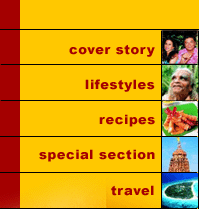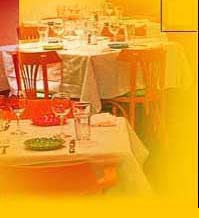


|
|
|
IF you are an Oriya of Khetriya caste and living in Cuttack, you are bound to have adventurous tastebuds and a great love for food. Like Deepak Ku Samantaray, the city�s leading citizen, a civil engineer and builder with business interests in cinema halls, steel, oxygen plants and vanaspati. Next on his list is a resort in Puri for which he has already identified 100 acres of land. �We Khetriyas are a typical Oriya family, but our eating habits are not restricted, we eat everything,� he said, laying out a table in his modest bungalow for us to have breakfast. These Khetriyas come from Kolar, a village 65 kilometres away, where they have a 135-year-old ancestral home. Deepak�s wife Jayanti looks like a Southern film star, tall and statuesque, olive skinned and with big, dark eyes. (Their children Akash and Lavanya take after her.) She is a Suryavanshi, which is a royal lineage, and Jayanti comes from the royal house of Kanika, which is in Bhadrak on the coastal belt outside Bhubaneshwar and where the famous crocodile sanctuary exists. The happy marriage between this Khetriya and Suryavanshi has produced a fairly exciting menu in the Samantaray household.
�The eating habits of all Khetriyas are like this,� Deepak says proudly. �We are hearty non-vegetarian eaters. We even relish pork products. Ham is almost like a delicacy. Many Khetriyas keep piggeries in Orissa. And we cook our pork like we cook mutton, in Oriya style recipes, not like in Continental or Chinese cuisine. It is marinated with mustard oil, mashed onion, ginger, coriander and little curd. Then it is cooked spicy with red or green chillies, dry onions and a little water in an earthen pot.� He says he himself can cook this pork dish to great satisfaction. But otherwise the Khetriya breakfast can also be a little Southern in influence. They make a dosa called Chittopitha especially when they have a puja at home, that is cooked on both sides and made with rice and coconut.
And we make our own ghee, dohi and chenna (cheese) at home daily for our food. We keep cows. And we also have coconut plantations from which we take coconuts and use in our cooking. The water from these coconuts is sweet and nourishing. You must taste it. It is not like what you will get in Kerala, Mangalore or Goa.�
|

Home Page
About the mag
Subscribe
Advertise
Contact Us
 Liver With Potatoes & Fish In Mustard For Breakfast
Liver With Potatoes & Fish In Mustard For Breakfast
 For breakfast, which is made in a kitchen by cooks who have been with the family for 37 years and supervised by Jayanti, there is a spicy liver with potatoes dish on the table and also a fish fried in pepper and with mustard oil. This early on a Sunday morning! Plus, there are bhajiyas and a bhendi curry to be had with puris. And a dish called Monda Mitha, which is steamed rice stuffed with cheese, coconut and curd, and which tastes like a cheese bun, but into which the Samantarays occasionally stuff kheema also! And to go with the Lipton Green Label Darjeeling tea, there is rosogulla. This Oriya rosogulla is soft and not spongy like the Bengal variety. It is made from fresh cottage cheese and it is cooked in sugar syrup, not soaked in it. At any rate, the Samantarays begin their morning with a plate of it on Sunday.
For breakfast, which is made in a kitchen by cooks who have been with the family for 37 years and supervised by Jayanti, there is a spicy liver with potatoes dish on the table and also a fish fried in pepper and with mustard oil. This early on a Sunday morning! Plus, there are bhajiyas and a bhendi curry to be had with puris. And a dish called Monda Mitha, which is steamed rice stuffed with cheese, coconut and curd, and which tastes like a cheese bun, but into which the Samantarays occasionally stuff kheema also! And to go with the Lipton Green Label Darjeeling tea, there is rosogulla. This Oriya rosogulla is soft and not spongy like the Bengal variety. It is made from fresh cottage cheese and it is cooked in sugar syrup, not soaked in it. At any rate, the Samantarays begin their morning with a plate of it on Sunday. The poor man�s breakfast in Oriya is puffed rice and milk with little cottage cheese and salt. Or it is puri and dal with chewda. The Samantarays like their Kakharu Alu Dal, which is a gravied potato dish, and Alu Kaleji better. The fried fish in pepper is not what every Oriya family would chose to have unless it was affluent. But it is their marriage menus that Deepak would rather talk about. That time they have a variety of dals, pulavs, the traditional �dohi fish�, mutton curry with tomatoes and potatoes and at least three types of vegetables. Cottage cheese and saag must be there. And a payasam-like kheer, called Payas. Most of the food is cooked on firewood.
The poor man�s breakfast in Oriya is puffed rice and milk with little cottage cheese and salt. Or it is puri and dal with chewda. The Samantarays like their Kakharu Alu Dal, which is a gravied potato dish, and Alu Kaleji better. The fried fish in pepper is not what every Oriya family would chose to have unless it was affluent. But it is their marriage menus that Deepak would rather talk about. That time they have a variety of dals, pulavs, the traditional �dohi fish�, mutton curry with tomatoes and potatoes and at least three types of vegetables. Cottage cheese and saag must be there. And a payasam-like kheer, called Payas. Most of the food is cooked on firewood. Jayanti describes the Oriya Khetriya-Suryavanshi breakfast as a fairly simple meal despite the liver and fish on the table. �It is cooked simply,� she explains, �with onion, panch phoron (which is the Bengali-Oriya equivalent of Chinese five-spice powder and made of green fennel seeds, black mustard seeds, black nigella, yellow fenugreek seeds and sage-coloured cumin seeds), garlic. It is easy to digest this food. Mustard oil is the medium of cooking. Or sunflower oil.
Jayanti describes the Oriya Khetriya-Suryavanshi breakfast as a fairly simple meal despite the liver and fish on the table. �It is cooked simply,� she explains, �with onion, panch phoron (which is the Bengali-Oriya equivalent of Chinese five-spice powder and made of green fennel seeds, black mustard seeds, black nigella, yellow fenugreek seeds and sage-coloured cumin seeds), garlic. It is easy to digest this food. Mustard oil is the medium of cooking. Or sunflower oil.